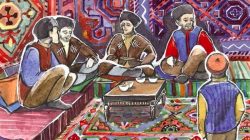
Caharkala/Agency Caucasus – There is new evidence that Russians used pieces of the monumental Chechen tombstones as construction materials in the late 1940s after the Union of Soviet Socialist Republics, or USSR, which was the absolute authority then in power across the entire Caucasus, exiled Chechens both to Siberia and the Central Asia.
It was first in 1993 when Jahar Dudayev, the then President of Chechnya, officially voiced the fact that Russians had in fact used the Chechen tombstones while they had constructed buildings in the late 1940s.
Among the ruins of Yermolovsky, a chicken factory established while the USSR was in power in the Alkhan-Kala village of Caharkala, capital of Chechnya, were spotted some tombstones on May 13. These tombstones show details about the people who died between 1920 and 1930.
The Yermolovsky chicken factory was closed down in the 1990s. Afterwards, it was left in ruins because it was loomed. Nowadays, people only visit the area if they want to take some time off the work.
It is a young man, called Lech, who accidentally spotted the tombstones while he was walking around the area. "When I first spotted the tombstones, I could not just ignore them and leave the scene. Instead, I tried to make it known to my friends as well," Lech said, and added that he could not ignore what he saw because "these tombstones are sacred to us, and more importantly, the sheer ferocity of using the sacred tombstones in buildings needs to be dealt with."
Formerly, the use of tombstones was also detected in the ruins left of roads, buildings and other different types of construction. The tombstones that were found were gathered in an area in central Caharkala, called "The Monument." Most tombstones are either brought to Caharkala or to the nearest graveyard after they are found.
Work with the search of tombstones is receiving support from a non-governmental organization, named ‘The Search of the Lost,’ whose chairman is Tamara Talhigova.
The tombstones should be seen as the perfect reminiscences of the Chechen culture, said Hamzat Umhayev, a human rights official of the Russian-guided Chechen administration. "Each tombstone is a master’s work of handcraft. They have motives engraved on them. A look at the tombstones will not only tell us about the gender of the deceased person but it will also tell us about his/her ancestors and even about his/her profession. These monumental tombstones are no longer manufactured. For that reason, they should be treated as works of art."
The use of tombstones in buildings was considered to be an example of vandalism in words stated by Ali Ordashev, the imam of the village. These tombstones would never disappear from view, he said. "However hard the governments try to render the tombstones a thing in the past so that nobody could any longer see, they will remain visible to use in one way or another. Each tombstone has the name of God engraved on it. We should consider this to be important. They were used as construction materials. How human is it to use them in building? We Muslims never do this kind of thing, because Islam never tolerates any kinds of vandalism." CT/ÖZ/FT








